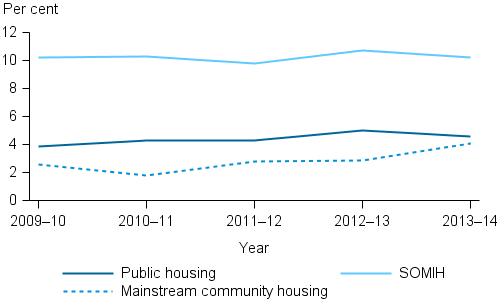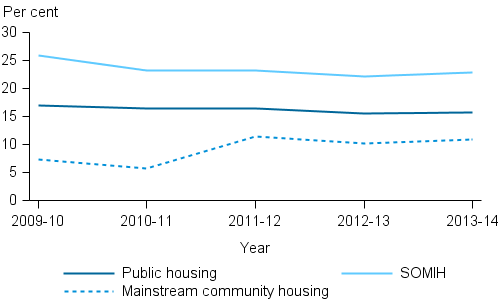Matching dwelling size to household size
A large part of providing affordable housing that meets the needs of individuals and families is ensuring that the size of a dwelling is adequate to meet the needs of the household. Matching dwelling size to household size is not a straightforward process; as family composition changes over time relocation to more suitable housing can be complicated by the availability of dwellings, tenants willingness to relocate and the cost of rehousing existing tenants.
The current stock of social housing was built around working families, so about 45% of current public rental housing stock, 81% of state owned and managed Indigenous housing (SOMIH) and 31% of mainstream community housing, consists of houses with 3 or more bedrooms. In contrast, the profile of social housing tenants has changed over time with almost half (48%) of all tenants in 2013–14 single adults.
The Canadian National Occupancy Standard (CNOS) is currently used to measure the extent to which a dwelling matches the size of a household.
Whilst the CNOS is a useful guide to the proportion of dwellings that may be under-utilised, or proportion of households potentially living in over-crowded conditions, there are some cases where a dwelling may not match a household size. For example, with shared custody of children, live-in care arrangements or to take into consideration future needs of children who may need separate bedrooms in years to come.
As at 30 June 2014, the majority of social housing households (around 77%) were classified to be dwellings adequate to their household composition.
Overcrowding
Overcrowding occurs when the dwelling is too small for the size and composition of the household living in it. A dwelling requiring at least 1 additional bedroom according to the CNOS is designated as 'overcrowded'.
| Overcrowded | Adequate | Under-utilised | |
|---|---|---|---|
| Public rental housing | 5% | 80% | 16% |
| SOMIH | 10% | 67% | 23% |
| Mainstream community housing | 4% | 85% | 11% |
Location
The proportion of overcrowded households varied across social housing programs by jurisdictions and remoteness areas.
As at 30 June 2014, the Northern Territory had the highest proportion of overcrowded households in public rental housing (7%), followed by Victoria (6%). South Australia had the lowest proportion of households living in an overcrowded condition (2%). SOMIH households in Queensland reported the highest proportion of overcrowding (14%), whereas SOMIH households in Tasmania reported the lowest (4%). Community housing households were most overcrowded in New South Wales (6%), and least overcrowded in the Australian Capital Territory (less than 1%).
Overall, Indigenous households are more likely than non-Indigenous households to be overcrowded. The higher level of overcrowding among Indigenous households may be associated with a number of factors, including cultural and social differences, higher levels of unmet demand for affordable housing, and geographical location.
Overcrowding in Indigenous households in social housing increased by remoteness area. Indigenous households that were overcrowded in public rental housing were more likely to be in Very remote (12%) and Remote (11%) areas. SOMIH households in Very remote (17%) and Outer regional (12%) areas were more also likely to be overcrowded than other SOMIH households.
Overall, overcrowding within Indigenous households increased with remoteness

Trends
Between 2009–10 and 2013–14, the prevalence of overcrowding has varied across social housing programs. The proportion of SOMIH households living in overcrowded conditions has consistently remained more than twice as high as other social housing programs. Overcrowding in public rental housing has increased from 4% in 2009–10 to 5% in 2014, and SOMIH overcrowding remained stable at 10% over the same period. Overcrowding in community housing has increased from 3% in 2009–10 to 4% in 2013–14.
Figure 1: Proportion of overcrowded households in social housing, 2009–10 to 2013–14 (per cent)

Source: AIHW National Housing Assistance Data Repository, 2013–14. Source data
Underutilisation
Underutilisation of social housing is where the dwelling size is larger than required to adequately house the household. Underutilisation can arise as a household ages and children leave the family home, where tenants have been living in a home for many years and their economic and community life is centred around that location, and there are no suitable alternatives for relocation. Underutilisation is also in part due to public rental housing being dominated by family-sized homes with 3 or more bedrooms.
As at 30 June 2014, underutilisation rates were 16% in public rental housing and 11% in community housing. Indigenous households were more likely to experience underutilisation, with 23% of SOMIH households classified as underutilised.
Location
As at 30 June 2014, the proportion of underutilised housing varied by jurisdictions and remoteness areas across the social housing programs.
Underutilisation varied greatly across social housing programs and remoteness areas, but overall, South Australia had the highest proportion of underutilisation.
For public rental housing, South Australia had the highest proportion of underutilisation (26%), followed by the Australia Capital Territory (16%). The Northern Territory had the lowest proportion (7%).
For SOMIH households, South Australia reported the highest proportion of underutilisation (28%). Queensland reported the lowest (16%).
For community housing households, those in South Australia (25%) were most underutilised while those in the Australian Capital Territory (2%) were least underutilised.
By remoteness area, the proportion of underutilised households in public rental housing varied substantially, with Outer regional areas most likely to be underutilised (21%) compared to Major Cities and Remote areas (both 15%). Underutilisation of SOMIH ranged between 19% in Very Remote areas to 23% in Major Cities, Inner regional areas and Outer regional areas.
Trends
Between 2009–10 and 2013–14, trends in underutilisation across community housing households have been varied, whereas SOMIH and public rental housing underutilisation has remained relatively static over time.
Public rental housing underutilisation decreased from 17% in 2009–10 to 16% in 2013–14, and SOMIH underutilisation is down from 26% in 2009–10 to 23% in 2014. Underutilisation in community housing has increased from 7% in 2009–10 to 11% in 2013–14, however, community housing has maintained comparatively low levels of underutilisation compared to other social housing programs.
Figure 2: Proportion of underutilised households in social housing, 2009–10 to 2013–14 (per cent)

Source: AIHW National Housing Assistance Data Repository, 2013–14. Source data


